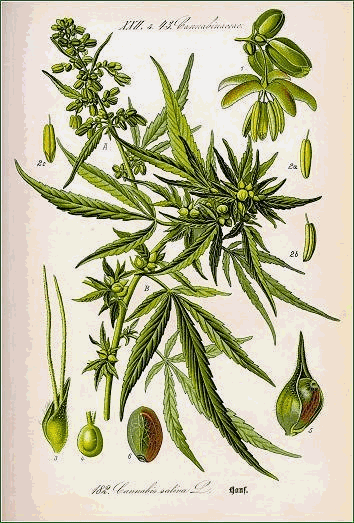
 Cannabis.
Cannabis.
Compiled and Edited by Ivor Hughes
Cannabis.
Indian hemp and resins obtained from Indian hemp and all
preparations (except extract and tincture of Indian hemp) of which such
resins form the base.
Any extract or tincture of Indian hemp. Any preparation, not being a preparation capable of external use only, made from extract or tincture of Indian hemp.
Cannabis (the dried flowering or fruiting tops of Cannabis sativa (Linn.) The resin of Cannabis; extracts of cannabis; tinctures of cannabis; cannabin tannate.
Rule 10 of the Poisons Rules, 1952, exempts from the First Schedule provisions all corn paints in which the only poison is a poison included in the Poisons List under the heading of 'Cannabis'.
Cannabis (B.P.C. 1949). Cannab.; Cannabis Indica; Indian Hemp; Ganja; Guaza; Chanvre Indien; Hanfkraut; Marihuana; Canamo indiano.
Foreign Pharmacopoeias: In Belg., Egyp., Fr., Ind., Span., and Swiss.
The dried flowering or fruiting tops of the pistillate plant of Cannabis sativa (Cannabinaceae). Protect from light.
The active principle of the drug is contained in the resin (cannabinone) which contains Cannabinol, C21H28O2, which resinifies on exposure to air and becomes less active, though even long storage of whole cannabis does not entirely destroy its activity.
The masses obtained in European commerce are called Guaza. Bhang consists of specially dried leaves and flowering shoots of both male and female plants, wild or cultivated. Ganja consists of dried flowering tops of the cultivated hemp plant which become coated with a resinous exudation. Charas is the name given to the resinous matter collected from the leaves and flowering tops of the plant, and constitutes the active principle of hemp; the best quality and the maximum amount of resin is obtained from plants grown in Yarkand in Chinese Turkestan, and the major part of the Charas produced in Chinese Turkestan finds its way into India. In S. Africa it is smoked under the name of dagga.
Toxic Effects. Toxic doses cause vertigo and collapse but serious poisoning is rare and fatalities unknown since the margin between the effective and the fatal dose is wide. Addiction does not give rise to serious physical consequences and, except in severe cases, withdrawal symptoms are insignificant. Continued use of the drug may lead to mental deterioration but insanity is a rare sequel.
The physiological activity of the hemp plant varies with the locality in which it is grown. The minimum fatal dose by the mouth of charas, ganjah and bhang works out at 2 g., 8 g. and 10 g. per kg. body weight respectively.�R. N. Chopra and G. S. Chopra, Indian med. Res. Mem., No. 31, 1939, pp. 1-119.
A case of cannabis intoxication from the smoking of cigarettes made from the dried leaves and tops of plants grown in England.� E. T. Baker-Bates, Lancet, i/1935, 811. See also, W. A. J. Fleming, ibid., 1301.
Addiction among marihuana users is unlike addiction among the users of morphine or heroin. With these latter the victim must have the drug to feel normal, but with marihuana the addict wants to recapture the pleasurable euphoric state into which the drug lifts him. It is more of a psychological condition, there is no marked physiological disturbance on withdrawal of the drug. After long usage, however, a dull state supervenes in which the victim is for all practical purposes an addict, and in which ethical and intellectual deterioration and apathy are the outstanding factors. � W. Bromberg, Med. Rec. N. Y., 1935, 142, 309. Marihuana: a psychiatric study.�W. Bromberg, J. Amer. med. Ass., 1939, 113, 4.
Uses. Doses of 2 grains or more, whether ingested or smoked, cause euphoria, mental confusion, hallucinations and motor excitement. The initial phase of inebriation is succeeded by irritability and somnolence, and after some hours by a comatose sleep. Cannabis was formerly employed in mania and nervous disorders as a cerebral sedative or narcotic but, owing to the uncertainty of its action, it is now seldom used. It has occasionally been used for the relief of migraine and of headache due to hypertension.
HERPES ZOSTER. Administration of the extract in pill form, � to � grain, according to age, 3 times a day, quickly relieves the pain.� C. E. Matthews, Brit. med. J., ii/1939, 431.
Ext. Cannab. (B.P.C. 1949). Extract of Cannabis. A soft extract prepared by percolation with alcohol (90%). Protect from moisture. Dose: 16 to 60 mg. ( � to 1 grain). It was usually given in pill form with lycopodium.
Mist. Cannab. Indic, (formerly Chelsea Hasp, for Women). Tincture of cannabis 10 m., spirit of nitrous ether 30 m., dilute solution of ammonium acetate 60 m., mucilage q.s., camphor water to 1 fl. oz.
Tinct. Cannab. (B.P.C. 1949, Ind. P.). Tincture of Cannabis. Extract of cannabis 5 g., alcohol (90%) to 100 ml. When dispensed in mixtures, mucilage must be added to suspend the resin. Dose: 0.3 to 1 ml. (5 to 15 minims). Belg. P., Fr. P., and Span. P., 1 in 10.
See also: ... Indian Hemp ... Hemp
![]()